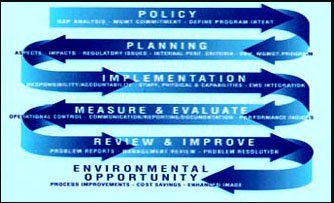Environmental Management
An environmental management system (EMS) was interpreted as the organizational structure, including practices, processes, resources and responsibilities for implementing environmental management. Such a system enabled tanneries to achieve and demonstrate ongoing compliance with regulations. It allowed tanneries to control the environmental impact of all activities, products and services taking into account a self determined environmental policy and objectives. These objectives included those environmental aspects, which organization could control and over which they could be expected to have an influence. The standards were based on the concept that organization periodically reviewed and evaluated systems in order to improve environmental performance.
Benefits of EMS
Following benefits were achieved by implementing the Environmental Management System in leather industries
1. Legislation compliance.
2.Resource conservation, Energy conservation.
3.Minimize health risks, protect human lives & environment.
4.Opportunity to improve and maintain the quality of environment.
5.Amicable public and community relations. Ultimately, EMS made a tannery cost effective and enhanced its exports.
Need for EMS for Leather Sector
Leather is one of the major exports of Pakistan. Quality of Pakistan's leather is the main factor behind its high international demand. New regime of international trade under WTO demands that the production of leather is in compliance with environmental standards. In the coming years, if these standards are not taken seriously, Pakistani leather and leather products will not be accepted by the international market.
To sustain and enhance the exports of Pakistani leather and leather products in international market, implementation of environmental systems is now a pre- requisite for each tanning unit.
In this regard, the progressive units in leather sector have already implemented EMS and are acquiring ISO 1400 I certification.

STAGE-I: Formulate Policy
The environmental policy is the basic tool, which helps to improve the organization's environmental management system, and helps to implement the same through systematic and scientific approach. Basically the policy is commitments of management towards the establishment of environmental friendly process. The policies are prepared on the basis of the organization's defined objectives and targets.
STAGE-II: Planning
EMS planning was to decide why the company was pursuing the development of an EMS. The key step is gaining top management's commitment to support EMS development and implementation. Secondly, a team is to be developed with representatives from key management functions
(such as engineering, finance, human resources, production and/or service) that can identify and assess issues, opportunities, and existing processes for planning.
STAGE-III: Implementation
At the stage of implementation the EMS is operationalized, clear definitions of roles, responsibilities and authorities for different categories of employees is pre-requisite. Simultaneously, training program, communication system, document control system, internal standards development, operational procedures and emergency plans are need to be initiated.
STAGE-IV: Measure and Evaluate
Responsible personals and authorities review all the implemented measures periodically, and if needed, corrective actions may be taken for further improvement.
STAGE-V: Review and Improve
Top management is responsible to review and evaluate the performances of all the implemented measures of EMS with the aim of further and continuous improvement in the current practices and to make it more effective for the organization.